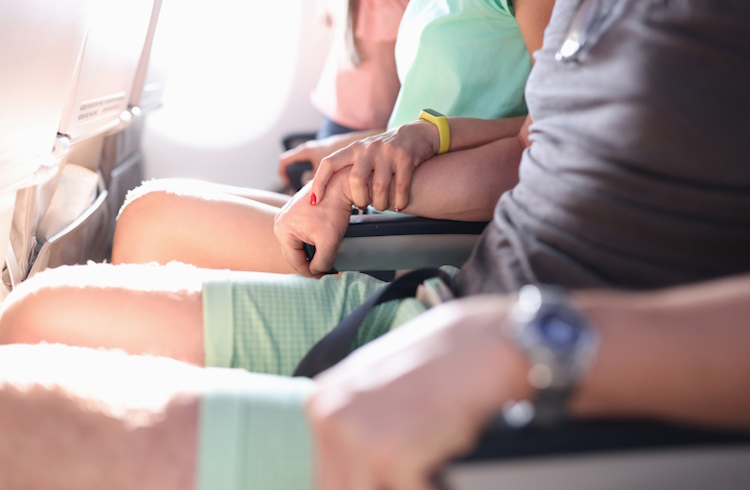How to Get Over a Fear of Flying
Racing hearts, sweaty palms, and anxiety attacks – being a nervous flyer is not a nice experience, but there are ways to understand and overcome the condition. Sarah Thomas shares her tips.
 Photo © Getty Images / Ivan-balvan
Photo © Getty Images / Ivan-balvan
Rachel Murphy, a 50-year-old community manager from Sydney, Australia, says flying is a challenge for her, not least in keeping it together in front of her 10-year-old son.
“My kid loves flying,” she says. “He’s a very good traveler and I try extremely hard not to pass my fear onto him. I remember going through turbulence when he was a baby and I was trying to laugh about how bumpy it was and how it was like driving down a bumpy road, while absolutely freaking out in my head.
“I don’t think he has noticed how scared I get. Sometimes I’ve tried to hold his hand and he’s been like, ‘I’m OK, Mum!’ I don’t want to say, ‘It’s for me!’”
It’s estimated up to 40 percent of people, like Rachel, have some sort of fear of flying, or aviophobia. It’s a particularly irrational fear given the safety statistics. In 2019, in pre-Covid times, 4.5 billion passengers were carried on 46.8 million commercial flights. In that year, there were 257 fatalities caused by air crashes, which was also a 50 percent drop on the previous year. The International Air Transportation Association (IATA) says on average a person would have to travel by air every day for 103,239 years to experience a fatal accident.
But the reality is air travel can spark all sorts of anxiety and stress – with lots of famous names in the mix showing just how severe and profound the syndrome can be. People such as David Bowie, Aretha Franklin, Ben Affleck, and Sandra Bullock, fearless trailblazers at the top of their game who have withstood many other pressures with resilience, are among those known to be overwhelmed by flying.
Thankfully, there are many ways to help understand and overcome a fear of flying and get a grip on those runaway anxiety levels. After all, anything that gets in the way of adventures and memories is a fear worth facing, but only in a way that is manageable for each individual.
- What causes fear of flying (aviophobia)?
- Finding help for flight anxiety
- What to do on the day of your flight
- Remember the destination
What causes fear of flying (aviophobia)?
In simple terms, it could be the mere concept of traveling at 35,000 feet in a tin can, or experiencing turbulence, incidences of which are increasing in line with climate change. People have also been affected by the halt on travel during the pandemic, which has thrown their coping strategies out of whack by making flying unfamiliar territory once again.
There are a number of basic triggers for a fear of flying, such as agoraphobia, claustrophobia, or a fear of heights, for example. Former US Air Force and commercial pilot Captain Tom Bunn has been running fear of flying courses since the 1980s, retraining as a therapist and developing a number of programs.
He says he first got involved in one of the early fear of flying programs when another pilot asked him to help out.
“I told him, "No, I don't want to be around a bunch of crazy people," because I thought that anyone who feared flying had to be a bit crazy. He insisted I give it a try and I got hooked: I was surprised to find that everyone in his course was intelligent and highly imaginative. It takes intelligence to think of a thousand things that can go wrong and the imagination to make each one of them seem real.”
Captain Bunn suggests that early childhood trauma and feelings of being out of control and unable to escape can build up a store of red flags which trigger stress hormones that can increase to the point where they overwhelm.
“At some point, the amount of stress hormones released when we are not in control or able to escape triggers panic,” he says. “For some kids, panic attacks start at puberty when ‘everything’ feels out of control. For others of us, we make it through to adulthood and then, as additional traumas plant more red flags, we – to our amazement – panic in an elevator, in an MRI scanner, or in an airplane.”
He says as part of his courses, people are taught information on how flying works, but also techniques to re-code thoughts into positive, comforting feelings, such as thinking of the person they feel most at ease with.
Finding help for flight anxiety
Some airlines run fear of flying courses, like British Airways’ Flying with Confidence course (there’s also a top-rated book of the same name linked to it). These can take the form of seminars explaining the nuts and bolts of flying, from how planes fly to common panic triggers like noises or turbulence. These courses can then be combined with a short “experience” flight to put knowledge into practice.
Captain Bunn’s website, Soar, has access to lots of resources. There are several other online guides too, like an e-book written by Paul Tizzard who worked with Virgin Atlantic on its fear of flying program.
It could also be worth talking to a therapist about anxiety and coping techniques.

What to do on the day of your flight
There may be a number of small measures you can take to help. For example, booking an aisle seat may help with claustrophobia, allowing you to stretch your legs slightly and easily get up and move around the cabin. You can also speak to the flight attendants on boarding and tell them you’re a nervous flyer so they can keep an extra eye on you and help put you at ease.
You might want to avoid stimulants like alcohol and caffeine to help keep nerves calm. Noise-canceling headphones and essential oils can be part of your anxiety-alleviating armory, too.
Remember the destination
Nervous flyers can be left wondering is it all worth it, so it’s important to keep the holiday, visit to friends, or whatever the reason for travel is top of mind. You may even get to where you can enjoy parts, if not all, of the flight.
“The really weird thing is that I love the middle bit on long-haul flights,” says Rachel. “I find the cabin cozy and I like the meal trays arriving. I love having long stints of time to read books or work on my laptop.
“My favorite flight ever is the five-hour flight from Sydney to Perth because it’s the perfect stretch of time to finish a trashy novel. If a flight is calm and there’s good weather, I’m OK and I can kind of white-knuckle through taking off and landing and enjoy the middle bit.”



No Comments